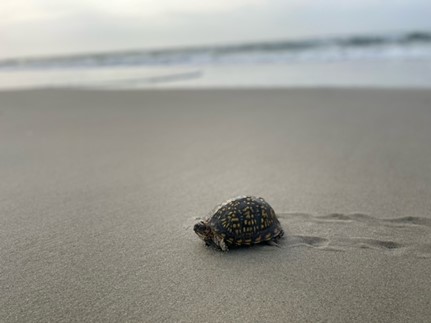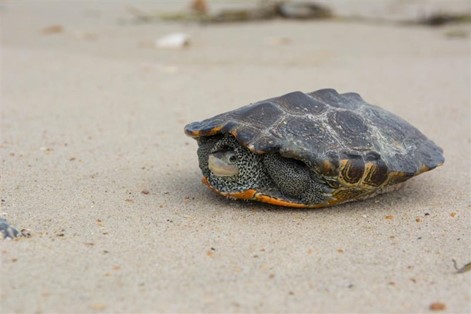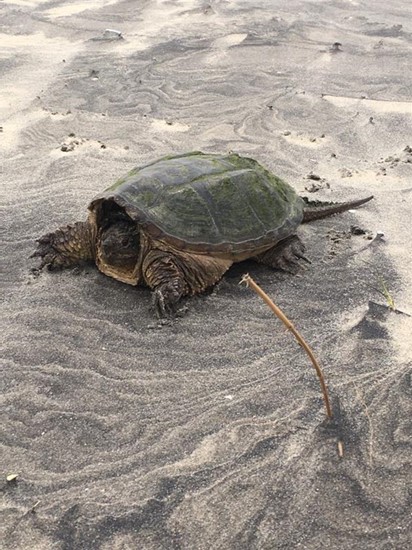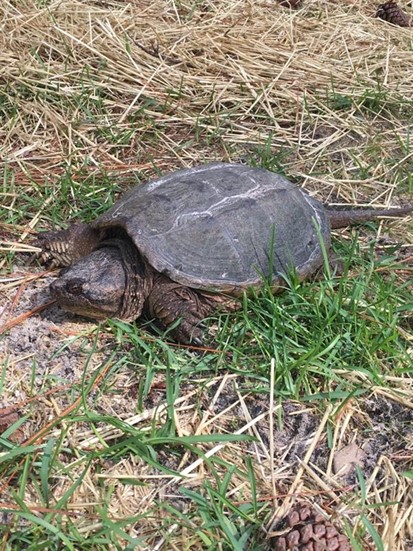By Ash Keiper-Kintz, Biological Science Technician at Cape Hatteras National Seashore
So, you’ve come across a turtle while visiting the beach, that means it’s a sea turtle, right? Not necessarily! Sea turtles aren’t the only turtles that enjoy the beach, they just get the best publicity! The Outer Banks actually has a wide variety of terrestrial and semi-aquatic turtles that also reside and nest here. This guide can help you differentiate and give you some tips on what to do if you encounter a turtle on the beach or road!

One of the easiest ways to tell the difference between a sea turtle and other types of land or freshwater turtle is to look at the feet. Turtle species that spend some time on land, like sliders or snappers, and turtle species that are fully terrestrial, like box turtles, all have something in common that sea turtles don’t—feet! Sea turtles have long paddle-like flippers, without separate toes. They do still have nails, but the toes that very early prehistoric species may have had are now fused into one powerful limb. Box turtles, snapping turtles, and all other varieties of non-sea turtles still have distinct and separate toes with a claw on each, although semi-aquatic species do have webbing between them. So, when you first want to identify if you have a sea turtle or not, look at the feet!
As a barrier island, one of the turtles we often get phone calls about is the diamondback terrapin (Malaclemys terrapin). This unique species is commonly mistaken for a sea turtle when visitors see them climb out of the ocean or sound to nest in sandy areas. These turtles, however, don’t spend most of their lives at sea. Instead, they both thrive in and in fact require brackish water. This means the water they live in is a mix of salt and fresh, not nearly as salty as the ocean itself. Diamondback terrapins are the only existing members of the genus Malaclemys and have a variety of adaptations that allow them to survive in the brackish water of bays, coastal wetlands, and estuaries like we have here in the Pamlico Sound. They can even spend time in the ocean in order to hop from island to island or make their way to better shores for nesting. With skin that is almost impermeable to salt, and special lachrymal glands like tear ducts that allow them to excrete salt in the same way as sea turtles, these little turtles are an evolutionary marvel! They can even sense minute differences in salinity and will drink rain as it falls and from water surfaces before it mixes with the saltwater.

Terrapins are much smaller than adult sea turtles, and get their name from the raised scutes, or scales on their shell. They can have light gray skin with many black dots and squiggles in a pattern unique to each turtle, and have strong pale jaws used for eating mollusks. Terrapins are currently most at risk due to loss of habitat from development and invasive plants like Phragmites encroaching on mud and sand flats where they would normally have nested. Many now nest and reside on the spoil islands between Hatteras and Ocracoke created by channel dredging.
If you happen to see one of these turtles attempting to cross the road, like all other non-snapping and non-sea turtles you should gently grasp them like a hamburger, supporting both the upper shell or carapace and lower shell or plastron. The turtle should be placed just off the road in the same direction they were originally headed. Most small turtle species are harmless, but the same claws they use to dig their nests can also be a hazard, so be careful! Turtles on Ocracoke also often use the sandy sides of the road where there is no brush to nest. If you see a non-sea turtle nesting on the side of the road, leave her be! Though this may be a higher risk area, it most likely won’t be her only nest of the year, and it is better to leave both the nest and the turtle undisturbed.
Another species commonly mistaken for a sea turtle on the seashore is the common snapping turtle (Chelydra serpentina). This is one of the most common species spotted crossing the roads of the seashore, and due to their unusual appearance and large size they are one of the species we often get phone calls about. They are also one of the only species this biotech would label as dangerous to handle. When encountering a snapping turtle that is crossing the road, size is important. This species can grow to 20 inches or larger, and weigh up to 35 pounds on average, with some of the heaviest caught specimens being over 60 pounds. Even 35 pounds of very angry turtle is not something I would recommend handling to anyone who isn’t a professional. But something that might surprise people who have only seen these turtles swim before is just how agile they can be on land. Common snapping turtles have impressively long and powerful legs that allow them to lift their entire body off the ground, normally used to pull them through debris and tangled plants in the water but also very useful for traveling miles during nesting season to find the perfect spot. For turtles larger than a dinner plate, your best bet for helping them to cross is simply stopping traffic at a distance and allowing it to make its way across on its own. You might be shocked by just how fast they can move when they want. Make sure not to stop in a location that puts you at risk where other drivers may not see you and use your hazard lights!

Snapping turtles are still more likely to survive a dangerous encounter by sitting down and scaring off whatever threatens them with their large and extremely powerful jaws rather than outrunning it. If they get spooked by being approached, they may lay down in the middle of the road, which isn’t the best defense against cars. Therefore, if a snapping turtle is not walking on its own and needs to be moved manually there are a few precautions you should take. Snapping turtles have one of the longest necks in proportion to their body size of any North American turtle besides the softshell species, hence their snake-like scientific name, C. serpentina. This means that they can reach their neck back over their shell to bite anywhere from their rear legs forward. There is a myth that holding these turtles by the tail is the safest way, but this can actually cause great harm to the turtle as this tail is an extension of their spine, and that much weight being put on the tail can injure their vertebral column. Instead, the safest place to grasp a snapper is by the carapace behind the back legs. Not an easy proposition if the turtle happens to be a larger one. In those cases, the best way is, as with most wildlife in need of help, to throw a towel over it. This way you can keep the neck immobilized while still holding from the rear and keeping the claws away from your hands. They are also very prone to lunging with their entire body as well as their long neck. All these reasons are why the best course of action is still to not spook the turtle into laying down in the first place, allowing it to cross on its own safely.
As for identifying these turtles, their tail is usually one of their most distinctive features, being particularly long, thick, and almost crocodilian in appearance. They are also one of the bulkiest turtles, particularly fleshy and unable to retract very much into their shells, instead relying on their beak to defend them. Unlike their larger cousin, the alligator snapping turtle, the common snapping turtle also has a small head in proportion to its body. They are naturally brown in color but are often tinted green by the algae that tends to grow over their shells. They rely mostly on crustaceans and fish as a food source but have also been known to take birds from below the water’s surface.
Now that you know about the two species most likely to be mistaken for a sea turtle, and how to safely transport any species across a road during nesting season, enjoy some photographs of some of the other species we encounter on the seashore!
About Ash
Ash has been a ranger here at Cape Hatteras for six years, five as a seasonal in Buxton and now as a permanent on Ocracoke Island. Before that they worked at various national parks, national forests, and national wildlife refuges across the country, from Oregon and Idaho to Utah, to South Carolina and Georgia. An avid bird lover, Ash came for the shorebirds but has come to love and appreciate the turtles as well. They enjoy photography, fishkeeping, and kayaking in their spare time.

